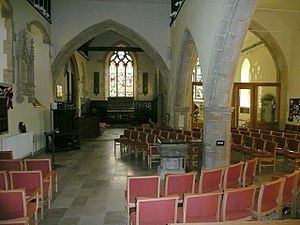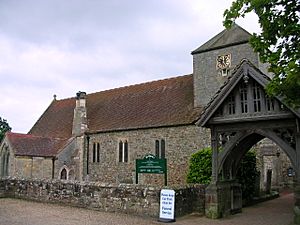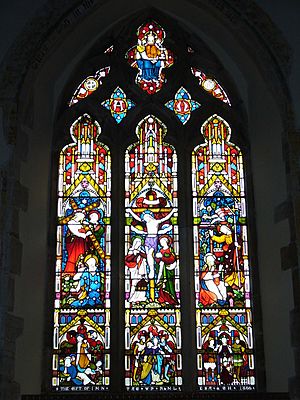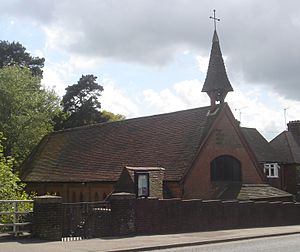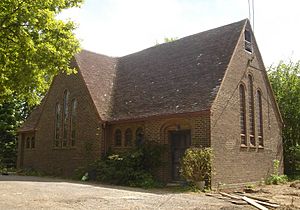St Mary's Church, Slaugham facts for kids
Quick facts for kids St Mary's Church |
|
|---|---|

The church from the north
|
|
| 51°02′18″N 0°12′29″W / 51.0383°N 0.2080°W | |
| Location | The Green, Slaugham, West Sussex RH17 6AG |
| Country | England |
| Denomination | Church of England |
| Tradition | Open Evangelical |
| Website | www.stmarysparish.org.uk |
| History | |
| Status | Parish church |
| Founded | 12th century |
| Dedication | Mary |
| Architecture | |
| Functional status | Active |
| Heritage designation | Grade II* |
| Designated | 10 September 1951 |
| Style | English Gothic |
| Administration | |
| Parish | West Weald (Slaugham and Staplefield Common) |
| Deanery | Rural Deanery of Cuckfield |
| Archdeaconry | Horsham |
| Diocese | Chichester |
| Province | Canterbury |
St Mary's Church is an Anglican church located in the village of Slaugham in Mid Sussex, England. This historic church was built in the 12th and 13th centuries and later updated during the Victorian era. It serves a large countryside area in the Sussex Weald, including three nearby villages. For many years, it was also connected to the church in Crawley, which is now a much larger town. An important local family, the Coverts, built their own private chapel inside the church in the 17th century. The memorials to their family members are considered very special. Because of its historical and architectural importance, English Heritage has given the church a special status called Grade II*. This means it is a particularly important building.
The Church's Long History
How St Mary's Church Began
The area where Slaugham is located was part of a region called the Rape of Lewes after the Norman Conquest. The village of Slaugham and its manor existed by the 11th century. It was owned by Lewes Priory, a religious house, from around 1098.
A powerful family, William and Gundred de Warenne, helped build churches in the area. They might have started a church in Slaugham. We don't have any parts of an 11th-century building, but the current church is likely built on its old foundations. The oldest parts we can see today are from the early 12th century. These include parts of the north wall, a doorway, and the font.
Building Changes Over Time
The church originally had a simple design with a nave (the main part where people sit) and a chancel (the area near the altar). The chancel was rebuilt in the early 14th century. In the late 13th century, a tower was added at the west end of the church. The entrance door in the tower is simple. The arch leading from the nave to the chancel is also from the 13th century and is unusually wide.
Around 1290, a south aisle (a side section) was added. It connected to the nave with wide arches. A tall, narrow window called a lancet window was put in the west wall of this aisle.
Adding More Features
Over the centuries, more parts were added to the church. The beautiful east window in the chancel, from the early 14th century, is in the Decorated Gothic style. Strong supports called buttresses were added to the tower in the 15th century. In the 16th century, two square windows were put in the north wall of the nave, next to an older, now-blocked Norman doorway.
A big change happened in 1613 when William Covert built a private chapel, known as the Covert Chapel. It was built on the south side, next to the chancel. The most important part of this chapel is a memorial to Richard Covert, who died in 1579. It shows him kneeling with seventeen other figures, representing his wives, sons, and daughters. The first letter of each person's name is carved above their head. This detailed stone memorial has Corinthian columns and carved flowers. Richard Covert is shown wearing armour, and his three adult sons are in military clothes. Both of his wives are reading prayer books. At the top are three helmets, two of which have the Covert family's coat of arms.
Victorian Updates and Beyond
Many churches in Sussex, including St Mary's, were updated or rebuilt during the Victorian era (1837-1901). Some work on the south aisle happened in 1827 to add 200 more seats. Most of the major work was done between 1857 and 1860 by architect Joseph Clarke. He added the top part of the tower, made the south aisle even wider, and created an archway between it and the Covert Chapel. He also built a vestry (a room for clergy) and an organ chamber on the north side. A 13th-century lancet window remains in the west wall of the south aisle, but Clarke added a rose window there too.
More changes continued later in the 19th century. A second vestry was built in 1879, the organ was moved, and a clock face was added to the tower in 1881. A 17th-century pulpit (a raised stand for preaching) was given to the church and installed in 1890.
The Churchyard
The churchyard is very large, showing how big the parish (the area the church serves) used to be. Famous people buried here include Catherine Matcham, who was one of Lord Nelson's sisters. There's also a table-tomb from 1615, which is one of the oldest graves of its kind in Sussex. You can also find wooden graveboards, which were a cheaper option than stone gravestones, and some unique iron grave-markers that look like gates. The lychgate (a covered gateway to a churchyard) at the north entrance was built in 1903. A very wide yew tree, which is over 600 years old, stands behind the church.
St Mary's Church was given its Grade II* listed status by English Heritage on October 28, 1957. This means it is considered "particularly important" and has "more than special interest." In 2001, it was one of 54 Grade II* listed buildings in the Mid Sussex area.
Church Design and Features
Overall Look
St Mary's Church doesn't look like it was all built at one time. You can clearly see how the building has grown and changed over many centuries. It has a west tower with an entrance, a chancel with a wide arch, a nave with a south aisle, the south (Covert) chapel next to the chancel, a south porch, two vestries, and an organ chamber. Most of the church is built from local Sussex stone rubble (rough, broken stones). Some parts, like the Covert Chapel, use ashlar (finely cut stone). The roofs are covered with slates and tiles, some of which are made from Horsham stone. The chancel roof still has one 14th-century tie-beam (a horizontal timber), but the rest has been replaced.
Windows and Light
The east window of the chancel is a 14th-century lancet with three trefoils (three-lobed shapes). The outside has a hood-mould above it. The north wall of the chancel also has a lancet window with quatrefoils (four-lobed shapes) and ogee (S-shaped) headings. The Covert Chapel has three windows with pointed arches. The one in the east wall has three cinquefoils (five-lobed lights), while the two in the south wall are simpler two-light windows. The north wall of the nave has one 19th-century window between two 16th-century windows and the old blocked Norman doorway. All three are simple two-light windows with straight tops. Two windows in the south aisle and the single window in the west wall are from the Victorian restoration. Charles Eamer Kempe designed several beautiful stained glass windows for the church in the 1890s.
The Tower and Bells
The tower has three sections. The bottom two are made of local rubble, and the top part, added in the Victorian era, is made of ashlar. You can still see the line where the different materials meet. Diagonal buttresses were added to the northwest and southwest corners in the 15th century. Only the lowest and highest parts of the tower have windows. There's a single-light trefoiled lancet window above the entrance and small round-arched windows on the side of the lowest section. At the top, the north wall has a clock, and the other three sides have 19th-century lancet windows. This top section also holds a ring of eight bells used for change ringing. Originally, there were five bells cast in 1773. Two of these original bells are still used today as part of the eight, with the others cast in 1934. The tower has a pyramid-shaped tiled roof.
Memorials and Other Features
The most important architectural features inside the church are its memorials and monuments. Besides the 1579 memorial to Richard Covert, the Covert Chapel also has a 26-inch (66 cm) brass monument of John Covert, who died in 1503. In the chancel, there's a special recess called an Easter sepulchre with brass monuments to an earlier Richard Covert (who died in 1546) and his three wives, showing the Resurrection of Jesus. Next to it is a memorial to his granddaughter, Jane Covert. Lord Nelson's sister, Catherine Matcham, has a memorial on the wall at the east end of the chancel.
The church once had 12th-century wall paintings, which were common in Sussex churches. These paintings, which showed scenes from the Passion of Jesus, no longer exist, but we have illustrations of them. One surviving feature from the 12th century is the square font made of local marble. It now sits on a modern base but still has many original carvings, including a unique fish design, arches, and tendril-style decorations. A 15th-century altarpiece (a work of art behind the altar) was moved from St Mary's to St Laurence's Church in Goring-by-Sea when that church was built in the 1930s.
The Parish and Its Chapels
Slaugham's Wide Reach
Slaugham has always been a very large parish. In 1940, it covered about 5,482 acres (2,219 ha), mostly quiet countryside. The three other villages in the parish—Handcross, Pease Pottage, and Warninglid—each had their own small churches, called chapels of ease, for Anglican worship. These chapels were controlled by St Mary's Church. All three buildings still exist today, but only one is still used for religious services.
Handcross Chapel
Handcross is a village with mostly Victorian buildings along the old London–Brighton road. All Saints Church is a small building made of red brick with a large, unique bell-turret at its west end. When the A23 London–Brighton road was changed and widened in the late 1950s, the church had to give up some of its land. The tiny building now sits right next to an overpass and hangs over the bypass.
Warninglid Chapel
Warninglid is a small hamlet about 1.25 miles (2 km) south of Slaugham. Architect Francis G. Troup designed a simple chapel of ease for the community in 1935. This was about a century after a chapel was first suggested for the area. The cross-shaped building was made of brick and had brightly colored stained glass windows by J. Hogan. The chapel, which cost £1,200, had a tall, vaulted interior lit by lancet windows. It was sold in 2009 and has since been turned into a house.
Pease Pottage Chapel
Pease Pottage is a small village on the southern edge of Crawley. A chapel of ease for St Mary's, later called the Church of the Ascension, was given permission to open in 1875. This small Gothic Revival-style building has been converted into an office. It features colorful brickwork, a bell-turret, and round-arched windows.
Crawley's Connection
Crawley, north of Pease Pottage, grew into a market town starting in 1202. It was originally part of Slaugham's parish. Soon after the market was created, the Poynings family, who owned most of the land, founded a chapel of ease in Crawley by 1267. This chapel later became a chantry (a chapel where prayers were said for the dead) for the Poynings family. It was later dedicated to St John the Baptist and opened for public worship. It remained a "daughter church" to St Mary's Church at Slaugham until the 16th century, though it became independent earlier in practice. St John the Baptist's Church is still the main Anglican church in Crawley and also has Grade II* listed status.
The current boundaries of Slaugham's parish are roughly the M23 motorway, part of the main railway line, the B2110 road, and the A23 road. On the south and west sides, fields and smaller roads form the border with other parishes.
See also


